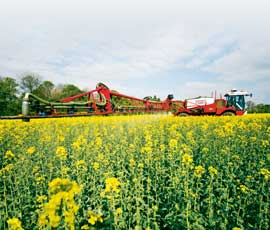VIDEO: Crop Watch – pressure on sprayer operators

There’s a common theme this week from our agronomists at all four points of the compass – rain.
The wet, windy and colder conditions we’ve been experiencing have put the pressure on sprayer operators struggling to find the opportunity to get out to apply crucial control packages.
But it’s not deep, rutted tramlines that are causing the issues this year – a dry autumn and winter mean in most places machinery can still travel. The hold-ups are being caused by wet canopies and blustery gusting showers.
And of course the rain has provided the perfect conditions for certain fungal pathogens to flourish.
Rape crops are out in flower across the country and, depending on their progress, may be experiencing some early petal stick. Of course, the wet will be helping with that and upping the sclerotinia threat. The advice is to consider a two-spray programme at both early and late flowering.
On the wheat front, septoria is obviously the biggest issue during the damp conditions.
Spore spread is generally helped by rain-splash, so spotting it early is one way of diagnosing any potential problems. And that’s the focus of our video this week – Marion Self tells us what to look out for and gives a few tips on yellow rust too.
If spray days are limited and T1 fungicides are delayed, when they are finally applied they need to be kept at a robust level, with triazoles bolstered by a strobilurin to handle any rust. The message is to grab a tank-load when the weather allows and not to be tempted to reduce rates while wet weather keeps things at high alert.
In winter barley some growers have been experiencing crops struggling to get going. This has now been identified as Barley Stunt – typically on lighter land where crops were sown early and establishment was slow.
Our man in the south – Agrii’s Iain Richards – reports the worst levels of BYDV he has seen in 23 years and is relieved that seed dressings and full-rate aphicides went on in the autumn. Most crops aren’t yet tall enough to suffer true lodging, but up north snow, followed by heavy storms, has knocked over some barleys, especially where headland overlaps have occurred with early nitrogen applications.
For a full regional round-up, see our Crop Watch blog.

